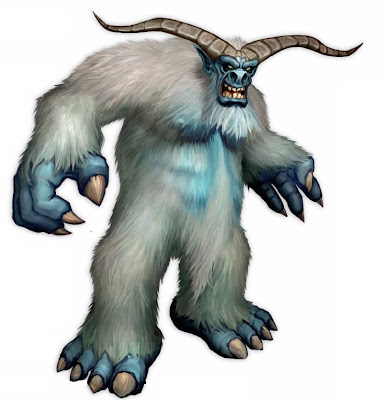Wendigo
In Everna, Wendigo can be found in cold places like Val'shka, Fjorn and Bjordan
Wendigo
The Wendigo (also known as Windigo, Weendigo, Windago, Waindigo, Windiga, Witiko, Wihtikow, and numerous other variants)[1] is a mythical creature appearing in the mythology of the Algonquian people. It is a malevolent cannibalistic spirit into which humans could transform, or which could possess humans. Those who indulged in cannibalism were at particular risk,[2] and the legend appears to have reinforced this practice as a taboo.
Wendigo psychosis is the name conventionally given to a culture-bound disorder which involved an intense craving for human flesh and the fear that the sufferer would turn into a cannibal. This once occurred frequently among Algonquian Native cultures, but has declined due to the Native American urbanization.[3]
Recently the Wendigo has also become a horror entity of contemporary literature and film, much like the vampire, werewolf, or zombie, although these fictional depictions often bear little resemblance to the original entity.
Contents[hide] |
[edit] In Algonquian mythology
The Wendigo is part of the traditional belief systems of various Algonquian-speaking tribes in the northern United States and Canada, most notably the Ojibwe and Saulteaux, the Cree, the Naskapi and the Innu people.[4] Though descriptions varied somewhat, common to all these cultures was the conception of Wendigos as malevolent, cannibalistic, supernatural beings (manitous) of great spiritual power.[5] They were strongly associated with the Winter, the North, and coldness, as well as with famine and starvation.[6] Basil Johnston, an Ojibwe teacher and scholar from Ontario, gives one description of how Wendigos were viewed:[7]
| “ | The Weendigo was gaunt to the point of emaciation, its desiccated skin pulled tautly over its bones. With its bones pushing out against its skin, its complexion the ash gray of death, and its eyes pushed back deep into their sockets, the Weendigo looked like a gaunt skeleton recently disinterred from the grave. What lips it had were tattered and bloody [....] Unclean and suffering from suppurations of the flesh, the Weendigo gave off a strange and eerie odor of decay and decomposition, of death and corruption. | ” |
At the same time, Wendigos were embodiments of gluttony, greed, and excess: never satisfied after killing and consuming one person, they were constantly searching for new victims. In some traditions, humans who became overpowered by greed could turn into Wendigos; the Wendigo myth thus served as a method of encouraging cooperation and moderation.[8]
Among the Ojibwe, Eastern Cree, Westmain Swampy Cree, Naskapi, and Innu, Wendigos were said to be giants, many times larger than human beings (a characteristic absent from the Wendigo myth in the other Algonquian cultures).[9] Whenever a Wendigo ate another person, it would grow in proportion to the meal it had just eaten, so that it could never be full.[10] Wendigos were therefore simultaneously constantly gorging themselves and emaciated from starvation.
[edit] Human Wendigos
All cultures in which the Wendigo myth appeared shared the belief that human beings could turn into Wendigos if they ever resorted to cannibalism[2] or, alternatively, become possessed by the demonic spirit of a Wendigo, often in a dream. Once transformed, a person would become violent and obsessed with eating human flesh. The most frequent cause of transformation into a Wendigo was if a person had resorted to cannibalism, consuming the body of another human in order to keep from starving to death during a time of extreme hardship or famine.[11]
Among northern Algonquian cultures, cannibalism, even to save one's own life, was viewed as a serious taboo; the proper response to famine was suicide or resignation to death.[12] On one level, the Wendigo myth thus worked as a deterrent and a warning against resorting to cannibalism; those who did would become Wendigo monsters themselves.
[edit] Wendigo ceremony
Among the Assiniboine, the Cree and the Ojibwe, a satirical ceremonial dance was originally performed during times of famine to reinforce the seriousness of the Wendigo taboo. The ceremonial dance, known as a wiindigookaanzhimowin in Ojibwe and today performed as part of the last day activities of the Sun Dance, involves wearing a mask and dancing about the drum backwards.[13] The last known Wendigo Ceremony conducted in the United States was at Lake Windigo of Star Island of Cass Lake, located within the Leech Lake Indian Reservation in northern Minnesota.[14]
[edit] Wendigo psychosis
The term "Wendigo psychosis" (also spelled many other ways, including "Windigo psychosis" and "Witiko psychosis") refers to a condition in which sufferers developed an insatiable desire to eat human flesh even when other food sources were readily available,[15] often as a result of prior famine cannibalism.[16] Wendigo psychosis has traditionally been identified by Western psychologists as a culture-bound syndrome, though there is a debate over the existence of phenomenon as a genuine disorder. The theory was popular primarily among psychologists in the early 1900s, and may have resulted from a misinterpretation of northern Algonquian myths and culture.[17]
In accounts of Wendigo psychosis, members of the aboriginal communities in which it existed believed that cases literally involved individuals turning into Wendigos. Such individuals generally recognized these symptoms as meaning that they were turning into Wendigos, and often requested to be executed before they could harm others.[18] The most common response when someone began suffering from Wendigo psychosis was curing attempts by traditional native healers or Western doctors. In the unusual cases where these attempts failed, and the Wendigo began either to threaten those around them or to act violently or anti-socially, they were then generally executed.[19] Cases of Wendigo psychosis, though evidently real, were relatively rare, and it was even rarer for them to actually culminate in the execution of the sufferer.[19]
One of the more famous cases of Wendigo psychosis involved a Plains Cree trapper from Alberta, named Swift Runner.[20][21] During the winter of 1878, Swift Runner and his family were starving, and his eldest son died. Twenty-five miles away from emergency food supplies at a Hudson's Bay Company post, Swift Runner butchered and ate his wife and five remaining children.[22] Given that he resorted to cannibalism so near to food supplies, and that he killed and consumed the remains of all those present, it was revealed that Swift Runner's was not a case of pure cannibalism as a last resort to avoid starvation, but rather of a man suffering from Wendigo psychosis.[22] He eventually confessed and was executed by authorities at Fort Saskatchewan.[23] Another well-known case involving Wendigo psychosis was that of Jack Fiddler, an Oji-Cree chief and shaman known for his powers at defeating Wendigos. In some cases this entailed euthanizing people suffering from Wendigo psychosis; as a result, in 1907, Fiddler and his brother Joseph were arrested by the Canadian authorities for murder. Jack committed suicide, but Joseph was tried and sentenced to life in prison. He was ultimately granted a pardon, but died three days later in jail before receiving the news of this pardon.[24]
Fascination with Wendigo psychosis among Western ethnographers, psychologists, and anthropologists led to a hotly debated controversy in the 1980s over the historicity of this phenomenon. Some researchers argued that Wendigo psychosis was essentially a fabrication, the result of naïve anthropologists taking stories related to them at face value.[25][17] Others have pointed to a number of credible eyewitness accounts, both by Algonquians and by Westerners, as evidence that Wendigo psychosis was a factual historical phenomenon.[26]
The frequency of Wendigo psychosis cases decreased sharply in the 20th century as Boreal Algonquian people came in to greater and greater contact with Western ideologies and more sedentary, less rural lifestyles.[3] While there is some substantive evidence to suggest that Wendigo psychosis did exist, a number of questions concerning the condition remain unanswered, and there is continuing debate over its nature, significance, and prevalence.
[edit] References in popular culture
While Wendigos have been referred to in literature for many decades (most notably in Algernon Blackwood's 1910 story "The Wendigo," which introduced the legend to horror fiction,[27] and in Stephen King's novel Pet Sematary[28]), recently they have become something of a stock character in horror and fantasy films and television, along the lines of werewolves and vampires, usually bearing very little resemblance to the Algonquian spirit. Appearances include the movies Wendigo[29] and Ravenous, and in episodes of the television series Blood Ties[30], Charmed[31], Supernatural[32], Haven[33] and others.
They also appear as characters in a number of computer and video games, including Final Fantasy,[34] The Legend of Dragoon,[35] and the Warcraft Universe,[36] as well as role-playing games such as Dungeons & Dragons.[37] Additionally, there is a Marvel Comics character known as "Wendigo".
They are referenced in music as well: the Cree singer-songwriter Buffy Sainte-Marie's song "The Priests Of The Golden Bull" asserts that the "money junkies" of the world are Wendigos.[38]




Comments